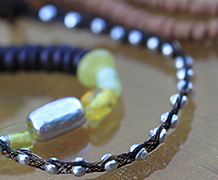
Replica Bronze Age bracelet
BBC reveals Dartmoor treasures with support from Exeter archaeologist
A rare and "amazing" burial discovery dating back 4,000 years has been described as the most significant find on Dartmoor: it is the subject of a new BBC2 TV programme on Sunday at 6.30pm.
University of Exeter archaeologist, Dr Linda Hurcombe contributed her expertise to the BBC programme ‘The Mystery of the Moor’.
The discovery of a Bronze Age granite cist, or grave, in 2011 in a peat bog on White Horse Hill revealed the first organic remains found on the moor and a hoard of about 150 beads. The National Park's archaeologists found an intact cremation deposit [human bones] which is actually a burial alongside a number of grave goods.
The park's chief archaeologist, Jane Marchand, said:"What was so unusual was the survival of so many organic objects which you never usually get in a grave of this period, they've long since rotted away."
Amongst the grave goods was an animal pelt, containing a delicate bracelet studded with tin beads, a textile fragment with detailed leather fringing and a woven bag. Dr Hurcombe expertise focused on the manufacture of a plaited hair bracelet inset with tin studs. She said:“Hair objects from this period exist but are incredibly rare, and I don’t know of any that have tin studs worked into the weave structure. When you look at the original bracelet you can see the delicacy of the paired individual hairs. These were plaited together to make a band only 4mm wide and yet so intricate.”
For the BBC programme Dr Hurcombe made a replica of the Bronze Age bracelet. In the original piece of jewellery the metal studs deteriorated, but the process of replication brought the beauty of this object back to life. The bracelet can now be seen to work at two levels.
Dr Hurcombe explained:“Up close you can see intricacy of the braiding but even from a distance you can see the shine of the tiny metal studs: it’s a delicate version of a punk studded cuff. It is assumed that the bracelet belonged to a rather special young woman, because by the standards of the age she had a lot of prestigious items buried with her.”
An additional project linked to the discovery includes a major exhibition at the Plymouth City Museum and Art Gallery, where the bracelet and other objects replicated for the film will be on display. The exhibition will open in the autumn 13 September until 13 December 2014.
Date: 7 March 2014
